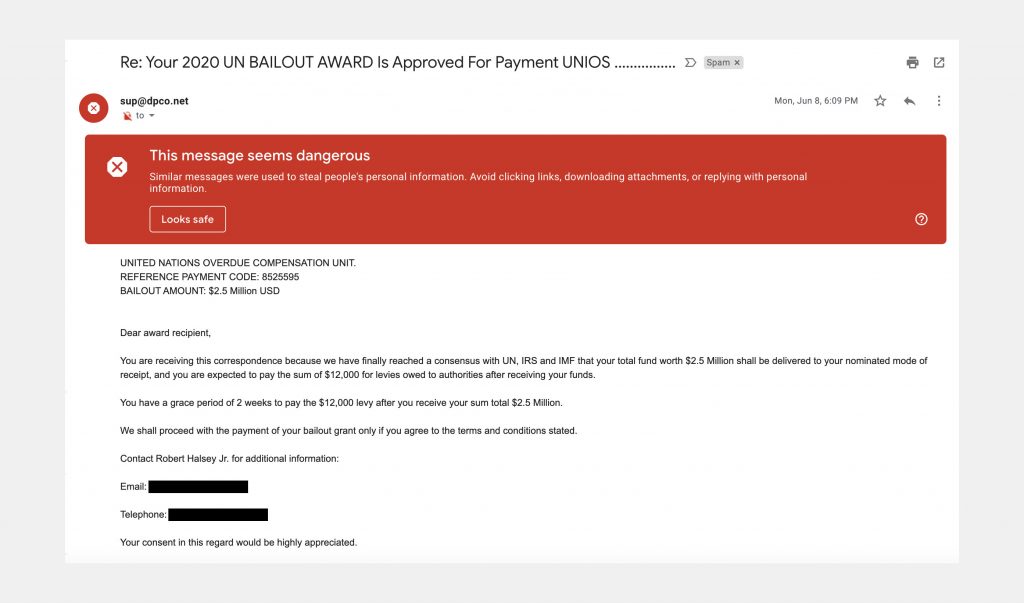Online shopping and e-commerce platforms have made our lives simple and easy. Gone are the days where settling for products at the local stores, and waiting for the new stock to arrive was the norm. With a boon in the online marketing industry, the range of products to choose from and the reviews to rely upon has made shopping a breeze. These online shopping benefits have made many consumers switch to e-commerce platforms for their needs. Nonetheless, everything comes with a price. The growing population of online shoppers has attracted many fraudsters to take advantage of the situation and make a quick buck. And every so often we hear about people falling prey to these miscreants and fraudsters. Fasten your seatbelts as we shed light on these online scams and share tips to stay sharp.
1. Email Scams

The first and the most common online scams we are all familiar with is the email phishing scams. Every once in a while, you would have probably received these scam emails from random email addresses. Some claiming to be old wealthy women with no heirs looking to transfer their wealth to a responsible charity or individuals. Or a lottery company asking you to claim your reward by sharing your bank account information. Most of these mailers seek valuable information from you that could be misused and make you vulnerable. In recent times however, these phishing emails have evolved from long letter formats to crisp website links that ask you to install viruses and malware to steal information from the computer.
How to stay Safe:
The best way to counter such mailers is to trash them immediately and read up online to stay updated about such mailers. Always check the sender information in the “From” section. Verify the domain name from where the email came. E-mail clients like Gmail will show additional information about the sender and their authenticity. Do not forward such emails to anybody. Simply mark it as spam so that the Email system learns to send such emails directly to spam.
2. Pagejacking (Replicating the design of a website for online scams)
Some online scammers use identical logos and dupe layouts of well-known shopping websites to con people. Untrusted websites and apps open windows of opportunities for these duped websites by pushing their ads onto our phones. And when people view these deep discounts on items at throwaway prices, they tend to dissolve their doubts and become the first to strike the deal. One such instance was the fake-flipkart scam, where many users fell victim to scam steal deals and made payments upfront without verifying the website. Many fraudsters camouflage themselves behind big corporations and e-commerce platforms. They misuse established e-commerce names to con people, with minor tweaks like names like flipkart to flpkart, amazon to amzon etc.
How to stay Safe
To avoid falling for such scams it is crucial to do some homework and check for the authenticity of such websites, most often times a deal that sounds ‘too good to be true’ will never be true. Always look at the domain name in the URL and compare it with the original. If you find additional characters such as hyphen, underscores etc, it’s a hint that the domain is not real. A simple hyphen b/w the words or letters in the domain makes it a completely different domain name.
3. Scam Websites
So far, we’ve discussed scammers that take the route of creating identical websites of established platforms to con people. There is another route that some con-men take using self-built websites. The real prize of these websites however, lies in the product listings and not the website itself. With the tools to build an attractive-authentic website within hours, scammers lure online shoppers onto their website by attractive discounts on various products. Victims fall prey to the low-priced products and order them, scammers deliver the copies of the original products and earn a buck on every order. Not realizing the authenticity of the products, consumers continue to get conned every now and then purchasing duplicate products at higher prices and become victims of the fraud.
4. Triangulation Fraud
A not-so-popular and advanced method of scam is the triangulation fraud. Where, almost everything is legitimate except for the price at which one purchases the product. Some may call this a basic marketing principle; however, some would call it unethical. In triangulation fraud, the seller uploads a fake listing of products with a significant price difference. And when a consumer shares the details to purchase a product, the seller captures it and uses it to buy from another website for a lesser price and ship it to them. The sorrowful reality of this scam is that the consumer never realizes that they overpaid for the product they ordered.
